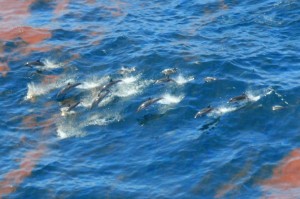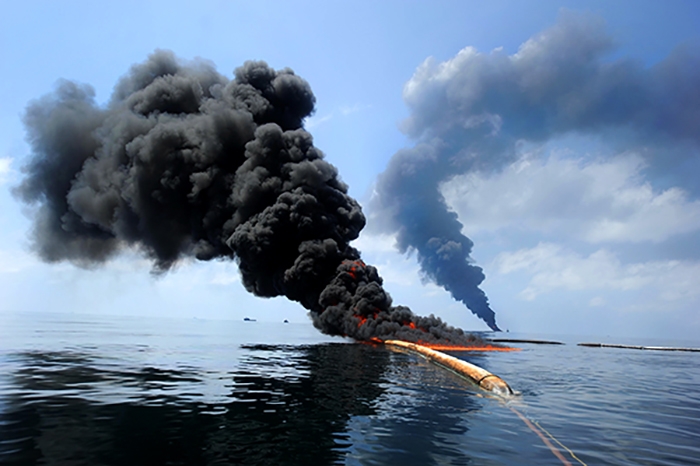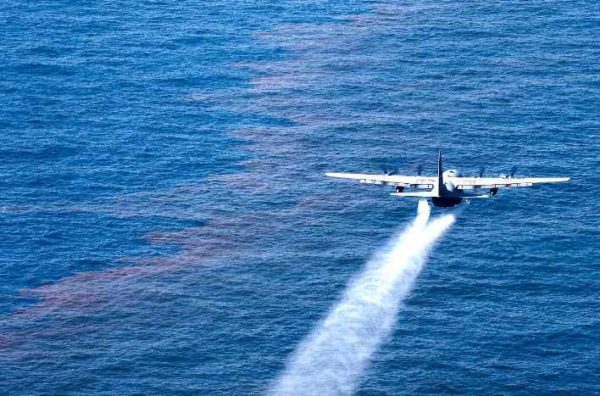This ongoing die-off, with the highest number of dead bottlenose dolphin strandings on recordin the northern Gulf of Mexico, coincided with the largest marine-based oil spill in the United States.

Barataria Bay, Louisiana, was one of the most heavily oiled coastal areas from the Deepwater Horizon oil spill, and the new study shows that half of the dead dolphins examined from Barataria Bay that stranded between June 2010 and November 2012 had a thin adrenal gland cortex, indicative of adrenal insufficiency. One in every three dolphins examined across Louisiana, Mississippi and Alabama had this lesion. In comparison, only 7 percent of the dead stranded reference dolphins, collected from other coastal regions outside the Deepwater Horizon oil spill area and time frame, had a thin adrenal cortex.
In fact, almost half of the dolphins with this otherwise rare adrenal lesion appeared to have died without another clear explanation for their death.
In addition to the adrenal lesions, the scientific team discovered that more than one in five dolphins that died within the Deepwater Horizon oil spill footprint had a primary bacterial pneumonia. Many of these cases were unusual in severity, and caused or contributed to death.
“These dolphins had some of the most severe lung lesions I have seen in the over 13 years that I have been examining dead dolphin tissues from throughout the United States,” said Dr. Kathleen Colegrove, the study’s lead veterinary pathologist based at the University of Illinois. In comparison, only 2 percent of reference dolphins had these lesions.
In other mammals, exposure to petroleum-based polycyclic aromatic hydrocarbons, known as PAHs, through inhalation or aspiration of oil products can lead to injured lungs and altered immune function, both of which can increase an animal’s susceptibility to primary bacterial pneumonia. Dolphins are particularly susceptible to inhalation effects due to their large lungs, deep breaths and extended breath hold times.
The prevalence of Brucella and morbillivirus infections, which were investigated as potential alternative causes for increased dolphin deaths, was low in UME dolphins after the oil spill and was no different compared to the reference dolphins. Additionally, biotoxin levels were either low or below the detection limit in the UME dolphins.

in 2010. (Credit:NOAA)
Ongoing studies assessing changes in these lung and adrenal gland lesions over time will help to address questions regarding how long these chronic conditions may last.
The study team included representatives from NOAA’s National Marine Fisheries Service, NOAA’s National Ocean Service, the National Marine Mammal Foundation, the University of Illinois, the University of Georgia, the Dauphin Island Sea Lab and University of South Alabama, the Institute for Marine Mammal Studies, Gulfport, Mississippi; the Louisiana Department of Wildlife and Fisheries, the Audubon Aquarium of the Americas, New Orleans; the Mote Marine Laboratory, Sarasota, Florida; the Texas Marine Mammal Stranding Network, Galveston; and the Marine Mammal Pathology Services, Olney, Maryland.
This work was completed as a part of the Northern Gulf of Mexico unusual mortality event investigation and a part of the Deepwater Horizon Natural Resource Damage Assessment being conducted cooperatively among NOAA, other federal and state trustees, and BP.
NOAA’s mission is to understand and predict changes in the Earth’s environment, from the depths of the ocean to the surface of the sun, and to conserve and manage our coastal and marine resources. Join us on Facebook, Twitter, Instagram and our other social media channels.
Pages: 1 2





